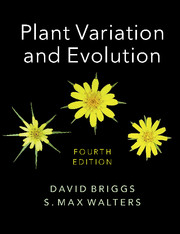Book contents
- Frontmatter
- Contents
- Preface to the Fourth Edition
- Acknowledgements
- Note on names of plants
- List of abbreviations
- 1 Investigating plant variation and evolution
- 2 From Ray to Darwin
- 3 Early work on biometry
- 4 Early work on the basis of individual variation
- 5 Post-Darwinian ideas about evolution
- 6 DNA: towards an understanding of heredity and molecular evolution
- 7 Breeding systems
- 8 Intraspecific variation and the ecotype concept
- 9 Pattern and process in plant populations
- 10 Pattern and process: factors interacting with natural selection
- 11 Populations: origins and extinctions
- 12 Species and speciation: concepts and models
- 13 Allopatric speciation and hybridisation
- 14 Abrupt speciation
- 15 The species concept
- 16 Flowering plant evolution: advances, challenges and prospects
- 17 Historical biogeography
- 18 The evolutionary impact of human activities
- 19 The taxonomic challenge ahead
- 20 Conservation: from protection to restoration and beyond
- Glossary
- References
- Index
2 - From Ray to Darwin
Published online by Cambridge University Press: 05 June 2016
- Frontmatter
- Contents
- Preface to the Fourth Edition
- Acknowledgements
- Note on names of plants
- List of abbreviations
- 1 Investigating plant variation and evolution
- 2 From Ray to Darwin
- 3 Early work on biometry
- 4 Early work on the basis of individual variation
- 5 Post-Darwinian ideas about evolution
- 6 DNA: towards an understanding of heredity and molecular evolution
- 7 Breeding systems
- 8 Intraspecific variation and the ecotype concept
- 9 Pattern and process in plant populations
- 10 Pattern and process: factors interacting with natural selection
- 11 Populations: origins and extinctions
- 12 Species and speciation: concepts and models
- 13 Allopatric speciation and hybridisation
- 14 Abrupt speciation
- 15 The species concept
- 16 Flowering plant evolution: advances, challenges and prospects
- 17 Historical biogeography
- 18 The evolutionary impact of human activities
- 19 The taxonomic challenge ahead
- 20 Conservation: from protection to restoration and beyond
- Glossary
- References
- Index
Summary
In 1660 Robert Sharrock, Fellow of New College, Oxford, wrote a book titled History of the Propagation and Improvement of Vegetables by the Concurrence of Art and Nature. He was concerned in its early pages to debate a live issue of the day (Bateson, 1913), namely:
It is indeed growen to be a great question, whether the transmutation of a species be possible either in the vegetable, Animal or Minerall Kingdome. For the possibility of it in the vegetable; I have heard Mr Bobart and his Son often report it, and proffer to make oath that the Crocus and Gladiolus, as likewise the Leucoium, and Hyacinths by a long standing without replanting have in his garden changed from one kind to the other.
The Bobarts were both professional botanists. Sharrock investigated their claim, and found ‘diverse bulbs growing as it were on the same stoole, close together, but no bulb half of the one kind, and the other half of the other’. In this age we find it hard to understand a belief in the possibility of transformation of Crocus into Gladiolus. Our reason for disbelief is partly concerned with the nature of evidence; we are not satisfied with the test for the alleged transmutation and would not have been content merely to examine the crowded underground parts. Another reason, however, relates to current ideas of the nature of species. We have a different notion of species from that of the seventeenth century.
Ray and the definition of species
It was the English naturalist John Ray (1628–1705) who was probably the first man to seek a scientific definition of species (Raven, 1950; Oswald & Preston, 2011). In his definition is an implied rejection of the sort of transmutation of species claimed by the Bobarts of Oxford, although in other passages in Ray's work he does not wholly dismiss the possibility of transmutation. For instance, he cites as reliable the case of cauliflower seed supplied by a London dealer, which on germination produced cabbage. Richard Baal, who sold the seed, was tried for fraud and ordered by the court at Westminster to refund the purchase money and pay compensation (De Beer, 1964).
- Type
- Chapter
- Information
- Plant Variation and Evolution , pp. 4 - 22Publisher: Cambridge University PressPrint publication year: 2016

